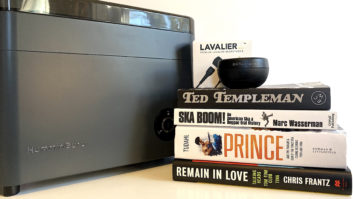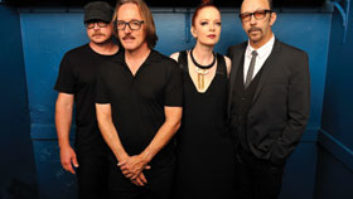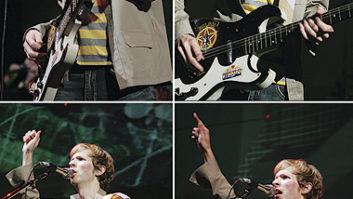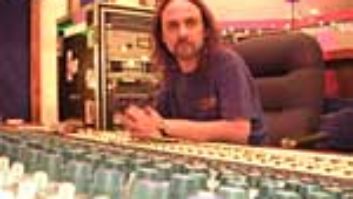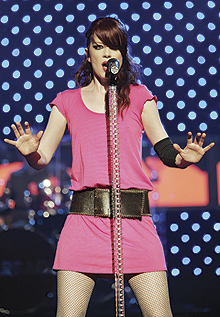
Vocalist Shirley Manson sings through an Audix OM5.
photo: Steve Jennings
During the four years between Garbage’s 2001 release Beautifulgarbage and their new album, Bleed Like Me, vocalist Shirley Manson, drummer/producer Butch Vig and guitarist/keyboardists Steve Marker and Duke Erikson endured illness, surgery (Manson’s vocal chords), a band breakup and marital dissolution (Manson again). But as the saying goes, “What doesn’t kill us makes us stronger,” and Garbage proves the point with one of the most initially successful albums of their career, supported by a European and U.S. tour recently ignited in early April at The Warfield in San Francisco.
Though recovering from a cold, the petite but fiery Manson appeared strong and ready to kick the sold-out crowd into submission as she stalked back and forth across the stage, joining her studio cohorts and touring bassist Eric Avery for a mix of old favorites and more stripped-down newer material.

Butch Vig, who also serves as the band’s record producer
Longtime Garbage front-of-house engineer Tom Abraham resumes his post for this tour, manning a Nexo GEO T tangent array system supplied by Michigan-based Thunder Audio. For the U.S. dates, the band is carrying 24 GEO T4805 full-range modules with four T2815 downfill cabinets, powered by NX241 digital controllers, the Lake Contour Pro 26 digital loudspeaker processor, Camco Vortex Series amps and 16 Nexo Alpha S2 subs. “The Alpha subs are more like an old-fashioned pile of 18s, which work better for the kind of gigs we do where things are really tight,” says Abraham. “It’s a beautiful, even-sounding P.A. It’s very small — the whole thing only weighs 1,500 pounds a side. And these gigs only have one sound point per side, so we can get this up in the air instead of doing some ground stack.”

Guitarist/keyboardist Duke Erikson
Abraham mixes the band on DiGiCo’s D1 digital console, while monitor engineer Clay Hutson works on a D5. Abraham notes that the D1 works well with the band’s streamlined setup, which requires only 30 inputs off the stage. Aside from EQ, dynamics processing and effects provided by the DiGiCo board, Abraham’s equipment roster includes a Roland SDE-330 delay, Eventide Eclipse with Version 3 software and a TC Electronic Gold Channel. “There’s no sound onstage; everyone’s on in-ears, so when I turn off the P.A., you don’t hear anything.” The band only uses three mics: an Audix OM5 for Manson’s vocals and two Audio-Technica 4050s for overheads. Drum sounds for Vig’s kit are loaded into a Clavia d-drum. “It makes everything that much more present,” says Billy Bush, Garbage’s studio engineer and guitar tech/programmer on the road. All inputs besides the mics are routed through Radial JDI direct boxes.

Front-of-house engineer Tom Abraham
One of Bush’s primary tasks was to translate their studio sound to a live setting. Guitar and bass effects are provided by two Line6 Pod Pro XTs and one Bass Pod, while keyboards are used with the Muse Research Receptor VST plug-in player. “We used a lot of soft synths and virtual synths making the record; figuring out how to re-create those was going to be a big problem because you can’t bring racks and racks of stuff [on the road].” Receptor contains a library of pre-installed plug-ins and also runs software synths, guitar processors and audio effects. “We run the M-tron Mellotron soft synth and [NI] Kompakt for all of our samples,” Bush says.

Guitarist/keyboardist Steve Marker
All bandmembers wear Sensaphonics ear molds and monitor through the Sennheiser EW 300 IEM G2 in-ear system. Hutson keeps the mixes pretty straightforward, “except for Shirley’s,” he says, “where there’s a lot of extra processing going on. Her band mix goes through a Waves L2 limiter, which makes everything sit in the pocket all the time. The band is really dynamic, and that doesn’t necessarily play well for in-ears because everybody wants to hear everything pretty linear all at the same time.” Hutson also uses an L2 on Manson’s vocal, along with an ATI Pro 6 mic pre. The absence of monitors means zero stage volume and no monitor volume, making Hutson’s job easier and allowing Abraham to crank the volume at FOH.
Abraham notes that despite the band’s stripped-down sound, “It’s a strange band to mix. You couldn’t just put it up like any four-piece rock band. It would sound kind of messy. You have to really know the songs.”

Monitor engineer Clay Hutson at the DiGiCo D5
According to Hutson, they also have to know their gear. “The tour has been based on the latest technology,” he says. “They’re very cool about us trying something new, and it seems to work right off the bat.”
Heather Johnson is a Mix assistant editor.
